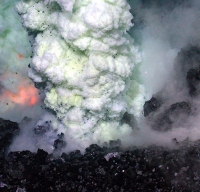
October Editorial
Boninite Lava discovered in the Lau Basin.

October Editorial
Boninite Lava discovered in the Lau Basin.
|
One of the most important components of the geological and geochemical cycles on Earth is the subduction of oceanic crust. Subduction occurs when two tectonic plates push against one another, and one plate starts to push the other deep into the mantle of the Earth. When plates slide against each other laterally, this often causes earthquakes. A common effect of subduction where the plates press directly against each other is the creation of an arc of volcanic activity at the edge of the subduction zone.
|
Most of the subduction zones in the earth’s surface developed at different times in the past 200 million years, with the most recent known subduction zones being about five million years old. These zones are constantly evolving, but until recently there have been few indications that a new zone may be developing. However, in November 2008 a Vents Program expedition of NOAA (NOAA is the National Oceanic and Atmospheric Administration of the USA) detected a plume of hydrothermal activity from a vent in the Pacific Ocean which suggested the presence of erupting lava flows and/or pyroclastic materials. | |
|
Recent research has shown that these might be signs of activity related to the early stages of the subduction process. The expedition returned to the area in 2009 to allow the scientists to study the area in more detail and collect samples. This area is approximately 200 km from Samoa, at a vent called West Mata. West Mata is a submarine volcano in the north-eastern Lau Basin at the northern end of the Tonga arc. The peak of volcano lies some 1170 meters below the ocean surface which means that West Mata is currently the world’s deepest erupting underwater volcano. However, what scientists find particularly interesting about this volcano is not its depth, but that the lava contains boninite. Boninite is a mafic (a slicate mineral rich in magnesium and iron) extrusive (flowing out) rock. It contains high levels of both magnesium and silica. The rock is typically composed of large crystals of pyroxenes and olivine in a crystallite-rich glossy matrix. Pyroxenes are important rock-forming minerals which have the general formula XY(Si,Al)2O6. ‘X’ in pyroxenes most commonly represents calcium, sodium, iron+2 and magnesium; while ‘Y’ is typically a smaller-size ion such as chromium, aluminium, iron+3, magnesium, manganese, titanium, vanadium or scandium. Olivine is a magnesium iron silicate with the formula (Mg,Fe)2SiO4. Boninite lava is very rare and has never before been discovered in an active volcano. In fact it usually occurs only during the formation of Earth’s subduction zones. So the research group led by the chief scientist Joseph Resing were excited to discover that the lava erupting from the West Mata was boninite. As Resing explained: “Nobody has ever collected fresh boninite from an active volcano and scientists never had the opportunity to monitor its eruption before ... . Scientists have only been able to study boninite collected from long-dead, relic volcanos millions of years old.” In an article just published in Nature Geoscience the researchers also showed that the West Mata emits large volumes of water, C02 and sulphur, which they think are derived from subduction resulting from a tear in the Pacific Plate. The volatile materials from the subducting part of the plate drive explosive eruptions that fragment rocks and generate incandescent magma bubbles and pillow lavas (lavas that form from an underwater eruption which are characterized by pillow-shaped masses). You can see the West Mata erupting lava on the video below: The authors estimate that the West Mata eruption has been going on for at least 2.5 years. They are hoping that the Lau Basin in which the volcano is situated will provide an important site for the long-term study of volcanic activity related to the early stage of subduction. Journal Reference: Joseph A. Resing, Kenneth H. Rubin, Robert W. Embley, John E. Lupton, Edward T. Baker, Robert P. Dziak, Tamara Baumberger, Marvin D. Lilley, Julie A. Huber, Timothy M. Shank, David A. Butterfield, David A. Clague, Nicole S. Keller, Susan G. Merle, Nathaniel J. Buck, Peter J. Michael, Adam Soule, David W. Caress, Sharon L. Walker, Richard Davis, James P. Cowen, Anna-Louise Reysenbach, Hans Thomas. Active submarine eruption of boninite in the northeastern Lau Basin. Nature Geoscience, 2011, 4, pp 799-806. | |
| _______________________________ | ||||
| Home | | | Shopping | | | Database |
© Biscuit Software 2004-2015
All rights reserved